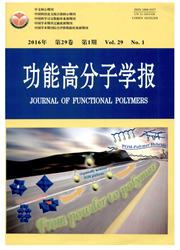

 中文摘要:
中文摘要:
采用熔融反应接枝的方法将(3-异氰酸酯基-4-甲基)苯氨基甲酸-2-丙烯酯(TAI)引入到聚苯乙烯-6-聚(乙烯-CO-丁烯)-b-聚苯乙烯三嵌段共聚物(SEBS)上,以实现SEBS的功能化。以傅里叶红外光谱(FT—IR)、核磁共振波谱(NMR)、凝胶渗透色谱(GPC)、动态力学分析(DMA)等手段对接枝物进行了表征。研究了引发剂、单体用量对接枝率及熔体流动速率的影响。结果表明:单体TAI的自聚倾向低,已成功接枝到SEBS上,接枝后的SEBS分子量高且分子量分布宽,接枝后聚(乙烯-co-丁烯)段的玻璃化转变温度提高。
 英文摘要:
英文摘要:
The styrene-b-(ethylene-co-l-butene)-b-styrene triblock copolymer (SEBS) was functionalized with allyl(3-isocyanate-4-tolyl) carbamate (TAI) via melting free radical grafting. The modified SEBS was characterized with Fourier transform infrared spectroscopy (FT-IR), nuclear magnetic resonance (NMR), gel permeation chromatography (GPC) and dynamic mechanical analysis (DMA). The effect of monomer and initiator concentrations on the grafting degree and melt flow rate was evaluated. The results showed that TAI had low tendency of homopolymerization and was successfully grafted onto SEBS molecule chain. The modified SEBS has high weight-average molecular weight (Mw) and wide molecule weight distribution (MWD) and high glass transition temperature.
 同期刊论文项目
同期刊论文项目
 同项目期刊论文
同项目期刊论文
 Biocompatibility of polypropylene non-woven fabric membrane via UV-induced graft polymerization of 2
Biocompatibility of polypropylene non-woven fabric membrane via UV-induced graft polymerization of 2 A facile route for preparing stable co-continuous morphology of LLDPE/PA6 blends with low PA6 conten
A facile route for preparing stable co-continuous morphology of LLDPE/PA6 blends with low PA6 conten Synthesis of amphiphilic poly(cyclooctene)-graft-poly(ethylene glycol) copolymers via ROMP and its s
Synthesis of amphiphilic poly(cyclooctene)-graft-poly(ethylene glycol) copolymers via ROMP and its s Preparation of PP-g-PEG by using partial pre-irradiated polypropylene as initiator and its propertie
Preparation of PP-g-PEG by using partial pre-irradiated polypropylene as initiator and its propertie Synthesis of amphiphilic polycyclooctene-graft-poly(ethylene glycol) copolymers by ring-opening meta
Synthesis of amphiphilic polycyclooctene-graft-poly(ethylene glycol) copolymers by ring-opening meta Functionalized polypropylene non-woven fabric membrane with bovine serum albumin and its hemocompati
Functionalized polypropylene non-woven fabric membrane with bovine serum albumin and its hemocompati Improved biocompatibility of poly (styrene-b-(ethylene-co-butylene)- b-styrene) elastomer by a surfa
Improved biocompatibility of poly (styrene-b-(ethylene-co-butylene)- b-styrene) elastomer by a surfa 期刊信息
期刊信息
